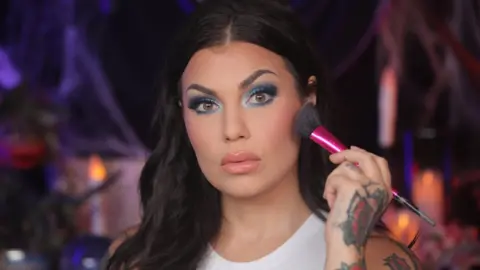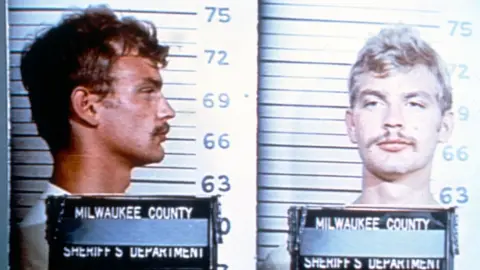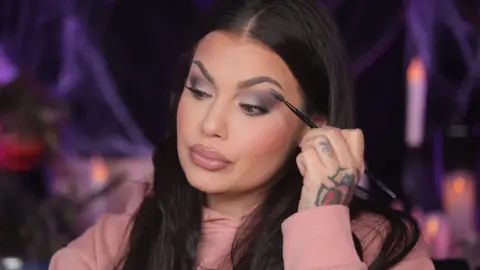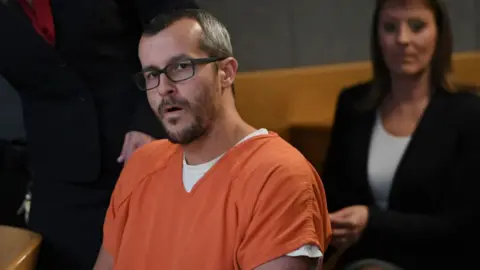The YouTuber making millions from true crime and make-up
 Bailey Sarian
Bailey SarianFor some, there are few things more relaxing than sticking a make-up tutorial on YouTube and settling in for a few moments of escapism.
Then there are those who like their make-up videos peppered with tales of depraved killers and their crimes.
Sound bonkers?
Not for the 6.4 million subscribers of Bailey Sarian, an LA-based make-up artist-turned-true crime maven.
Her YouTube videos combining these two utterly diametrically opposed subjects - a series called Murder, Mystery & Make-up - have turned from a hobby into a full-time career that, among other things, has led to deals with the likes of US streaming giant Netflix.
The 33-year-old herself is surprised that YouTube - and true crime - have become her day job.
"I thought it would be awesome to make money off of YouTube, to pay some bills," Ms Sarian tells the BBC. "Now that I got here with over six million subscribers, it is so much. I never imagined that it would turn into what it is today."
The premise of her videos is simple. Ms Sarian sits in front of the camera, putting on make-up and chatting about a true crime story. Each video takes an enormous amount of research - so much so that Ms Sarian now employs someone to help her - and includes information from court transcripts or police interviews.
The most popular video in the series is about notorious American serial killer Jeffrey Dahmer, who murdered 17 men and boys between 1978 and 1991, and whom Ms Sarian talks about while creating a sparkly green eye look with nude lip.
That video has been viewed more than 22 million times. Just for context, the finale of TV drama Line of Duty was watched by a record breaking 12.8 million people in the UK. Overall, Ms Sarian's YouTube videos have been viewed nearly 800 million times.
 Getty Images
Getty ImagesBut why does it work? Even Ms Sarian isn't sure: "To be honest, that's the one thing I still haven't figured out is why people like the make-up aspect of things."
Ironically, the whole thing came about by accident.
Up until around three years ago, Ms Sarian had mainly uploaded beauty tutorials on her channel, which she had started in 2013.
She was combining making YouTube videos with her job as a professional make-up artist. After striking a deal with the beauty subscription company Ipsy, Ms Sarian was able to rely more on YouTube for her earnings, though continued to freelance on occasion.
Then in 2018, a story emerged about a Colorado man called Chris Watts who was sentenced to life in prison for the murder of his pregnant wife Shanann and their two young daughters Bella and Celeste. It was a shocking crime that received worldwide coverage but Ms Sarian wanted to explore how someone had gone from the seemingly perfect husband to killing his family.
She was understandably nervous about talking about it. Online trolls are no joke, after all. To counter that, she did what she's always done - put on her make-up.
"I was doing it only because I felt awkward just sitting on camera talking and I wanted to keep myself busy," she says.
She was more nervous still about the response, which she expected to be terrible, "because I was doing make-up and talking about horrible crimes, you know, it doesn't make sense".
 Bailey Sarian
Bailey SarianWithin 24 hours though she knew she was on to something different as the viewing numbers stacked up. The Watts video eventually ended up with 10 million views.
"So I thought, 'Maybe, let me try it again with a different story and see if it performs the same way.' And it did, and I just kept going and every week it was just more subscribers and more subscribers," says Ms Sarian.
Dr Ruth Tully, a UK-based consultant forensic psychologist who has worked on serious crime cases, believes the combination works because of the way many of us watch content nowadays.
We might have one eye on the telly and another on our phone or tablet, otherwise known as "multi-screening".
"On the one hand she's doing something that, in itself, people can find highly absorbing in terms of watching someone apply make-up, like kids watch unboxing videos. So people are interested in watching that element on its own but also she's telling this story," says Dr Tully.
"We're thinking about the crime element that she is discussing yet there is also something visual to watch that isn't too gruesome that actually could be quite mesmerising in some way."

There's also the demographic. A snapshot of people watching true crime content on YouTube between January and June 2020 found that 60% were women. Ms Sarian says it is mostly women who watch her videos, with the biggest group those aged between 25 and 35, followed by 18 to 25-year-olds.
"There are a few ideas around why women in particular might be attracted to this," says Dr Tully. "Part of this has been cited as a way of processing our anxiety and that's about protecting ourselves. That might be driven by a lack of faith in systems for some women as well."
Ms Sarian says: "When I'm afraid of something, I try to figure it out, it helps the anxiety. At least that's why I get obsessed with it."
The Covid pandemic also fuelled subscriber numbers as the locked-down tore through TV series, films and anything else they could kill time with. When former US President Donald Trump called a national emergency in March 2020, Ms Sarian had just over 780,000 subscribers. By the end of the year, she'd hit 3.5 million and now has almost double that.
"There was nothing to watch," says Ms Sarian. "Everyone was on YouTube and people started finding my channel and binge watching all of my videos, and I got so many messages and comments from people saying, 'You got me through quarantine.'"
It has also widened her career. Ms Sarian now works with Audioboom on an award-winning podcast and video series called Dark History. Episodes include "Who stole grandma's body?! The Doctors' Riots of 1788".
There is also her deal with Netflix on its YouTube channel where she watches a film and attempts to work out whodunnit, which she says she got because someone at the streaming firm had come across her channel.
 Getty Images
Getty ImagesBehind the true crime stories she talks about though are real victims. Does Ms Sarian ever feel exploitative?
"Now that my channel's grown I do feel like I have more responsibility about what I say so my approach has been to focus more on the killers and not mention so much the victims or show pictures of them," she says.
"I feel like I can't speak for them unless I'm speaking to the family directly. They've lived such long lives, why be remembered for this one thing?"
She has in fact been contacted by people connected to some cases she has discussed. "There was always great feedback and then they want to add more." She says that if anyone connected to a crime was offended by a video she would take it down "no questions asked".
So what's next? Ms Sarian has another Dark History series coming out on 3 August and would like to see Murder, Mystery & Make-up shift to a bigger platform, perhaps a streaming service.
"But I'm honestly not sure," she says. "I'm just buckled in, going along for the ride."
